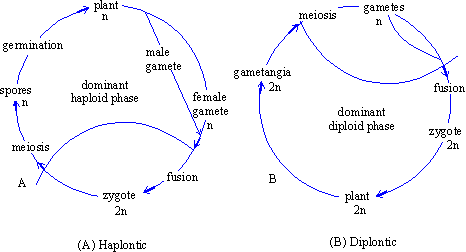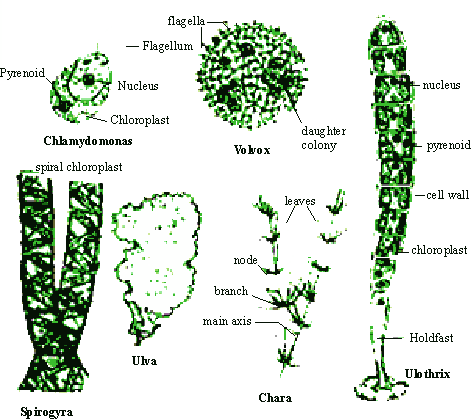|
PinkMonkey Online Study Guide-Biology
14.3 Kingdom : Plantae
Kingdom Plantae includes all organisms which are truly
multicellular and photosynthetic exept for algal protists. They are complex
autotrophs preparing food material by photosynthesis for themselves as
well as for rest of the other organisms. Hence, they are the chief producers
of the world. They are found in all the types of environment: aquatic
algae, amphibian mosses, and terrestrial ferns and seed-bearing plants.
The plantae are distinguished by the following characters:
(1) They are multicellular organisms, adapted to carry on photosynthesis, hence autotrophic.
(2) Presence of cell wall of true cellulose, enclosing cytoplasm with large vacuole.
(3) They perform photosynthesis due to chlorophyll present in chloroplasts.
(4) They may show alternation of sexual and asexual generations
in life-cycle.
(5) They are non-motile, without definite size and shape.
(6) Growth in these plants is intermittent.
They are classified as follows:

ALGAE
Algae are chlorophyll-bearing unicellular or multicellular
plants. When multicellular, they may be colonial or filamentous. Most
of them are aquatic, either fresh water, (Volvox), or marine, (Spirogyra).
Some are sheet-like (e.g., Ulva). Chlorophyll is present in chloroplasts,
the number and shape of which are characteristic of each alga. Besides
chlorophyll, they also show various carotenoid pigments which impart different
colors to algae. According to the nature of photosynthetic pigments, they
are further classified into three divisions such as Chlorophyta (green),.
Phaeophyta (brown), and Rhodophyta (red).
Life - cycles
Algae show both a gametophytic (haploid) stage and a
sporophytic (diploid) stage, which alternate. The life-cycle mainly shows
two types, either haplontic or diplontic.
 Click here to enlarge
Click here to enlarge
Figure 14.29 Types of life - cycles
(a) Haplontic life - cycle, when the plant body
is a gametophyte i.e., haploid and is dominant or of long duration,
and the zygote is diploid and of short duration.
(b) Diplontic life-cycle, when the plant body
is a sporophyte, i.e. diploid and is dominant or of long duration,
and the gametophyte is haploid and of short duration.
Green algae (Chlorophyta)
These algae live in wide variety of habitats, marine to fresh water to damp soil.
General Characteristics
(i) These are unicellular (Chlamydomonas), colonial
(Volvox) or filamentous. When filamentous they are unbranched
(Spirogyra, Ulothrix) or branched (Chara).
(ii) The cell wall consists of an inner layer of cellulose
and outer layer of pectic compounds and may be covered by a gelatinous
sheath.
(iii) The protoplasm is divisible into cytoplasm and nucleus. Cytoplasm contains one or more vacuoles. Chlorophyll is present in chloroplasts, the shape and number of which are characteristic of each alga.
(iv) Pigments chlorophyll-a and chlorophyll-b are predominant. However, carotene and xanthophyll are also present.
(v) Food reserve is in the form of starch surrounding the proteinaceous refractile bodies called pyrenoids.
(vi) Reproduction is vegetative by mitotic cell division in unicellular forms or by fragmentation in filamentous forms; asexual by formation of spores such as zoospores, aplanospores, hypnospore and akinates and sexual simply by conjugation or by gamete formation by isogamy or anisogamy or oogamy.
(vii) The life-cycle is of haplontic type showing alternation of dominant haploid stage with short-lived diploid stage.
Examples: Chlamydomonas, Volvox, Ulothrix, Spirogyra, Ulva etc.
 Click here to enlarge
Click here to enlarge
Figure 14.30 Types of Chlorophyta
|